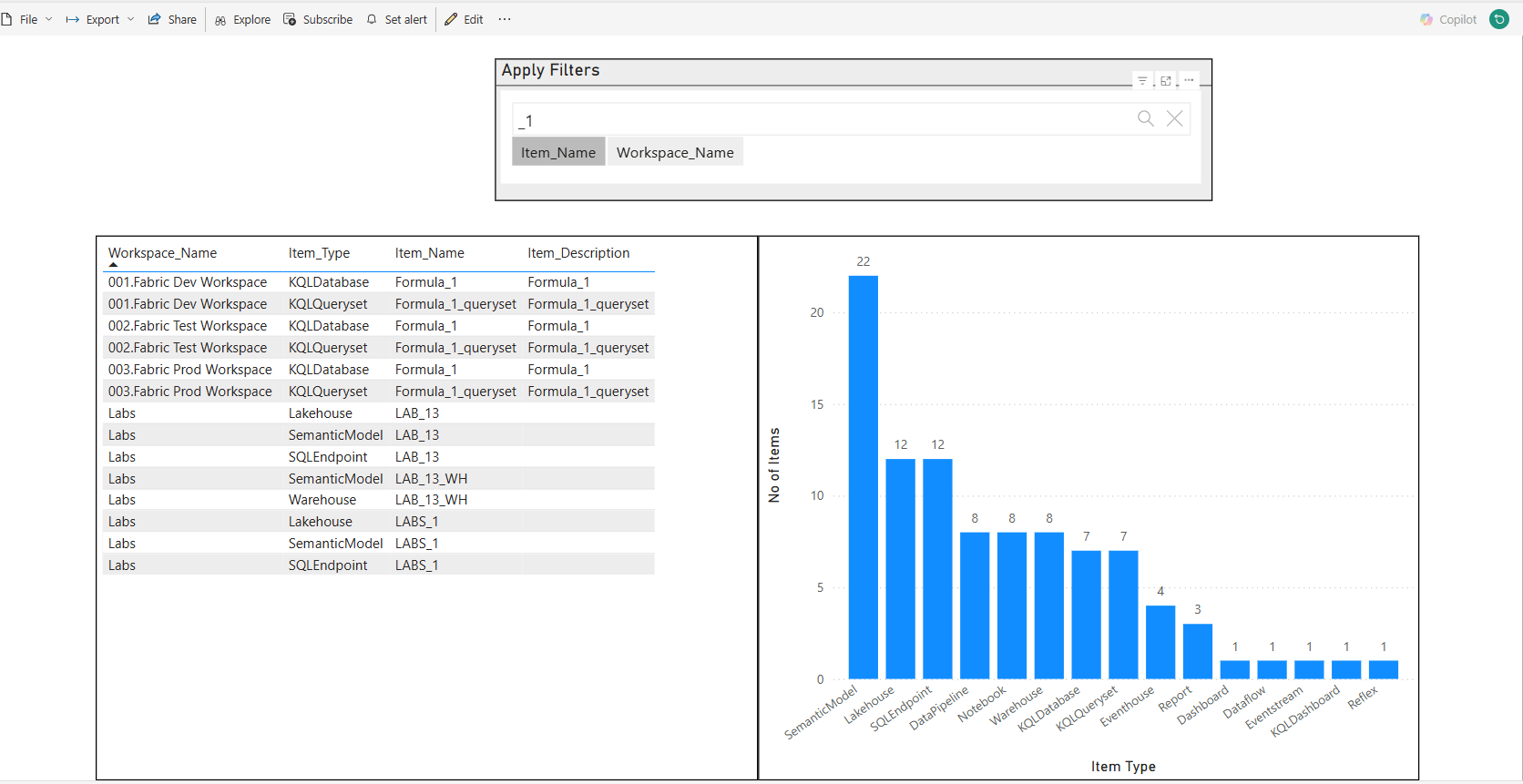Index of Fabric Workspace Items
by Eugene Mazarakis
Introduction
Often in Fabric, you need to locate a specific report or item (such as a notebook) but can’t remember which workspace it’s in. Typically, this involves using Fabric’s search bar or manually checking each workspace one by one. But what if you want to perform a more specific search?
Now, you can query the related table stored in the Lakehouse, which contains all the relevant information for each Fabric workspace. Alternatively, you can use a Power BI report that provides the same data and allows you to search directly and quickly identify the workspace containing the item you’re looking for.
The lakehouse table
Steps
- Create an empty lakehouse.
- Create a notebook with the related python code.
- Query the table in lakehouse through the SQL endpoint.
- Then you can go to create a power bi report with a search bar.
Following the python code:
#The following Python code creates a table in the lakehouse, listing the items contained in each workspace.
import pandas as pd
import sempy.fabric as fabric
# List workspaces and capacities
workspaces = fabric.list_workspaces()
capacities = fabric.list_capacities()
# Convert to pandas DataFrames
workspaces_df = pd.DataFrame(workspaces)
capacities_df = pd.DataFrame(capacities)
# Join workspaces with capacities on the capacity ID
workspaces_with_capacity = workspaces_df.merge(capacities_df, left_on='Capacity Id', right_on='Id', suffixes=('_workspace', '_capacity'))
# Filter the workspaces that are on dedicated capacity
workspaces_on_dedicated_capacity = workspaces_with_capacity.query('`Is On Dedicated Capacity` == True')
# Select relevant columns
result_tmp = workspaces_on_dedicated_capacity[['Name', 'Id_workspace' ,'Display Name', 'Capacity Id', 'Sku', 'Region', 'State']].rename(columns={'Name': 'Workspace_Name', 'Id_workspace': 'Workspace_Id','Display Name': 'Capacity_Name', 'Capacity Id':'Capacity_Id'})
# Create a list to hold all items from the workspaces
all_items_dfs = []
# Loop through workspaces and gather items
for ws in result_tmp['Workspace_Name'].values:
items = fabric.list_items(workspace=ws)
items_df = pd.DataFrame(items)
items_df['Workspace_Name'] = ws # Add workspace name to each row
all_items_dfs.append(items_df)
# Concatenate all_items_dfs into one Dataframe
all_items_combined_df = pd.concat(all_items_dfs, ignore_index=True)
# Rename all the columns
all_items_combined_df = all_items_combined_df.rename(columns={'Display Name': 'Item_Name', 'Description': 'Item_Description', 'Type':'Item_Type', 'Workspace_Name': 'Name_of_Workspace','Workspace Id': 'Id_of_Workspace'})
# Join workspaces and capacities with Workspace_Items on the Workspace Id
workspaces_with_items = result_tmp.merge(all_items_combined_df, left_on='Workspace_Id', right_on='Id_of_Workspace')
# Select relevant columns
result = workspaces_with_items[['Capacity_Name','Capacity_Id','Sku','Region','State','Workspace_Name','Name_of_Workspace','Workspace_Id','Id_of_Workspace','Item_Name','Item_Description','Item_Type']]
# Display the result in a tabular format
display(result.sort_values(by='Name_of_Workspace', ascending=True))
# Let's save dataframe as a delta lake, parquet table to Tables section of the default lakehouse
delta_table_name = 'workspaces_items'
spark.createDataFrame(result).write.mode("overwrite").format("delta").saveAsTable(delta_table_name)
Lakehouse Table
Now that the table has been created, you can run a query to search for any item in the Fabric workspaces using the LIKE operator with wildcards.
Power BI Report
The following is the Power BI report. Using the search bar, you can search for any item within the list visualization.


